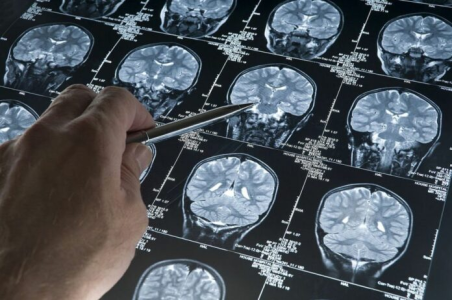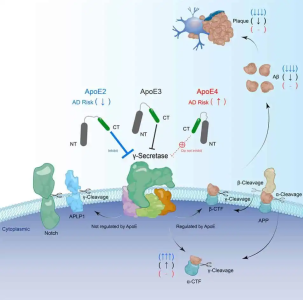New Alzheimer's Breakthrough: Scientists Discover We've Been Addressing the Disease Completely Wrong
As we age, our biggest concern may shift from our knees to our memory, and rightly so. Alzheimer's disease is a progressive, age-related neurodegenerative disorder that affects an alarming number of seniors—it is dementia's most common form, accounting for 60% to 80% of cases. But worry not, dear members, as the world of science has made a significant breakthrough that could change the way we tackle this debilitating disease.

According to a study recently published in Neuron, a critical link has been uncovered between the rare early-onset and common late-onset forms of Alzheimer’s disease. This newfound connection promises to offer more effective treatment strategies for the latter form, affecting most sufferers. Talk about a scientific breakthrough worth noting!
Now, let's dive a bit deeper into the nitty-gritty of the research findings. Alzheimer's disease can be categorised into two main forms: rare early-onset familial Alzheimer’s disease (fAD) and common late-onset sporadic Alzheimer’s disease (sAD). While both of these forms are associated with the formation of brain-clogging amyloid plaques, they differ in genetics, suggesting unique disease-causing mechanisms for each.
This raises a crucial question: is targeting amyloid plaques a genuinely effective treatment strategy for common sAD, or should we be seeking alternative approaches? Professor Chen Yelin's group from the Interdisciplinary Research Center on Biology and Chemistry at the Shanghai Institute of Organic Chemistry of the Chinese Academy of Sciences has found an answer—and it may require a significant rethinking of current Alzheimer's treatments.
Through their study, the scientists investigated the mechanistic relationship between the most common pathogenic risk factor for common late-onset sporadic Alzheimer’s disease (sAD) and the disease-causing genetic factors of the rare early-onset familial Alzheimer’s disease (fAD). In their groundbreaking findings, the research team revealed a missing link that could potentially revolutionise how we address Alzheimer's treatment.

So, what exactly did they discover? The researchers unearthed the role of ApoE4, a protein involved in the formation of amyloid plaques linked to Alzheimer's. People with two copies of the ApoE4 variant have a ten times higher risk of developing late-onset sAD compared to those with the standard ApoE3 variant. Conversely, the ApoE2 variant significantly lowers the risk of developing sAD. Understanding how these different ApoE variants affect Alzheimer's development could lead to new therapeutic strategies.
Alzheimer's disease has different forms, fAD and sAD, which have similar symptoms but differ in their genetic causes and when they appear. fAD is rare and associated with genetic mutations, while sAD is more common and usually develops after age 65, but the exact cause is still unknown. Although both forms involve the formation of amyloid plaques in the brain, the way they develop is different, making them difficult to distinguish.
The presence of different ApoE protein variants has been observed in both fAD and sAD, and these variants carry different levels of risk. ApoE4 variants, in particular, have been linked to an increased risk of Sporadic Alzheimer's Disease. Studying these different forms of ApoE provides valuable insights into the mechanisms of Alzheimer's and guiding potential treatments for the disease.
While more research is needed to fully understand Alzheimer's, this groundbreaking discovery has the potential to improve our understanding of the disease and open doors to more effective treatments.
 In short, it's a ray of hope for those affected by Alzheimer's disease and their families. This research breakthrough could lead to more effective treatments targeting the root cause of the common late-onset sporadic Alzheimer's disease, potentially improving the lives of millions of seniors worldwide.
In short, it's a ray of hope for those affected by Alzheimer's disease and their families. This research breakthrough could lead to more effective treatments targeting the root cause of the common late-onset sporadic Alzheimer's disease, potentially improving the lives of millions of seniors worldwide.
The future's looking brighter, one breakthrough at a time.

We've Been Approaching Common Late-Onset Alzheimer's Disease All Wrong: Scientists Uncover a New Clue. Source:Reyvuh.com
According to a study recently published in Neuron, a critical link has been uncovered between the rare early-onset and common late-onset forms of Alzheimer’s disease. This newfound connection promises to offer more effective treatment strategies for the latter form, affecting most sufferers. Talk about a scientific breakthrough worth noting!
Now, let's dive a bit deeper into the nitty-gritty of the research findings. Alzheimer's disease can be categorised into two main forms: rare early-onset familial Alzheimer’s disease (fAD) and common late-onset sporadic Alzheimer’s disease (sAD). While both of these forms are associated with the formation of brain-clogging amyloid plaques, they differ in genetics, suggesting unique disease-causing mechanisms for each.
This raises a crucial question: is targeting amyloid plaques a genuinely effective treatment strategy for common sAD, or should we be seeking alternative approaches? Professor Chen Yelin's group from the Interdisciplinary Research Center on Biology and Chemistry at the Shanghai Institute of Organic Chemistry of the Chinese Academy of Sciences has found an answer—and it may require a significant rethinking of current Alzheimer's treatments.
Through their study, the scientists investigated the mechanistic relationship between the most common pathogenic risk factor for common late-onset sporadic Alzheimer’s disease (sAD) and the disease-causing genetic factors of the rare early-onset familial Alzheimer’s disease (fAD). In their groundbreaking findings, the research team revealed a missing link that could potentially revolutionise how we address Alzheimer's treatment.

Unveiling the Connection: Researchers Make Groundbreaking Discovery on Alzheimer's Disease Risk Genes. Source: Reyvuh.com
So, what exactly did they discover? The researchers unearthed the role of ApoE4, a protein involved in the formation of amyloid plaques linked to Alzheimer's. People with two copies of the ApoE4 variant have a ten times higher risk of developing late-onset sAD compared to those with the standard ApoE3 variant. Conversely, the ApoE2 variant significantly lowers the risk of developing sAD. Understanding how these different ApoE variants affect Alzheimer's development could lead to new therapeutic strategies.
Understanding Alzheimer's Disease
Researchers have made an important connection between Alzheimer's disease risk genes, revealing insights into how this devastating condition works. They discovered that the abnormal cleavage of a protein called amyloid precursor protein is a crucial factor in both early-onset Familial Alzheimer's Disease (fAD) and late-onset Sporadic Alzheimer's Disease (sAD). They also found that a specific part of a protein called ApoE can inhibit γ-secretase, which could lead to potential therapies for Alzheimer's.Alzheimer's disease has different forms, fAD and sAD, which have similar symptoms but differ in their genetic causes and when they appear. fAD is rare and associated with genetic mutations, while sAD is more common and usually develops after age 65, but the exact cause is still unknown. Although both forms involve the formation of amyloid plaques in the brain, the way they develop is different, making them difficult to distinguish.
The presence of different ApoE protein variants has been observed in both fAD and sAD, and these variants carry different levels of risk. ApoE4 variants, in particular, have been linked to an increased risk of Sporadic Alzheimer's Disease. Studying these different forms of ApoE provides valuable insights into the mechanisms of Alzheimer's and guiding potential treatments for the disease.
While more research is needed to fully understand Alzheimer's, this groundbreaking discovery has the potential to improve our understanding of the disease and open doors to more effective treatments.
Key Takeaways
- A recent study has uncovered a crucial link between the rare early-onset and common late-onset forms of Alzheimer’s disease, potentially leading to more effective treatment strategies for the latter.
- The discovery of this missing link offers a new perspective on the disease and could change the way we approach treatment for common late-onset Alzheimer’s disease.
The future's looking brighter, one breakthrough at a time.







